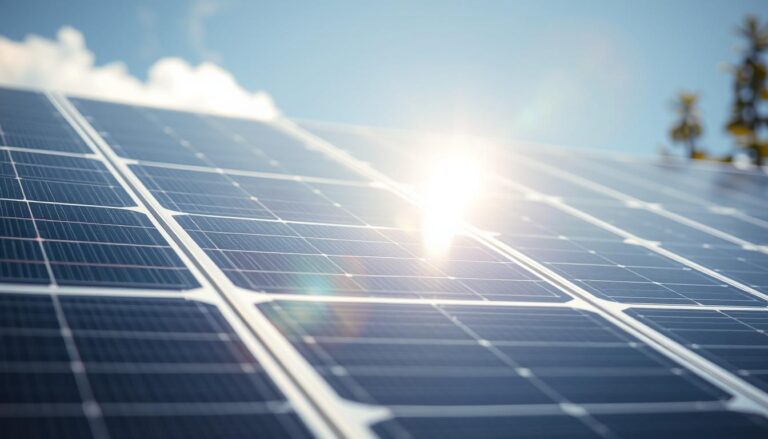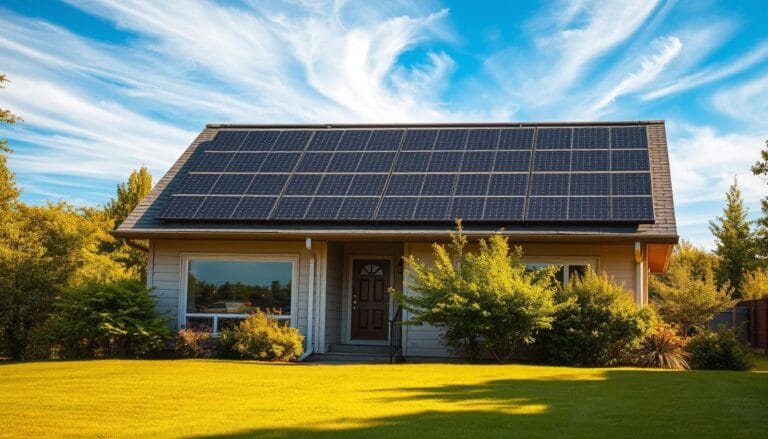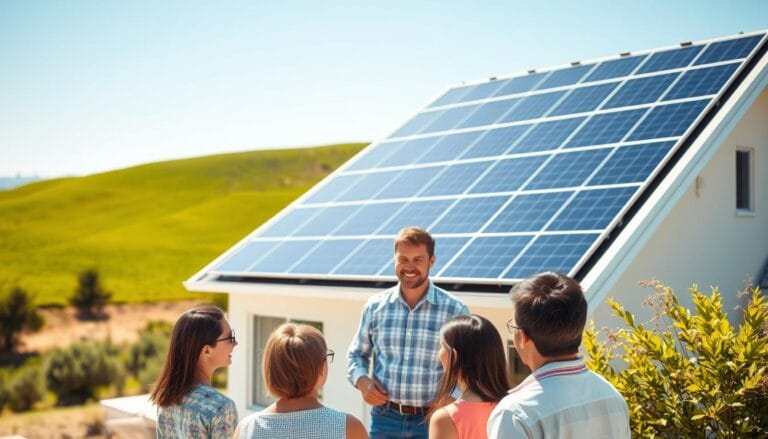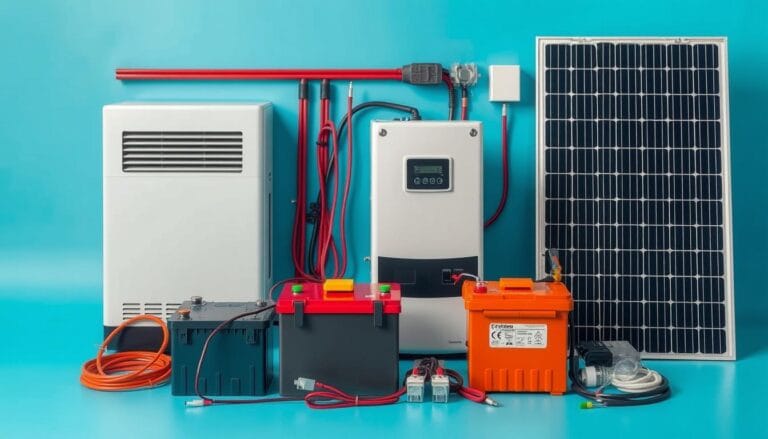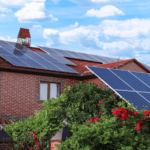The sun gives us a huge amount of energy every day. Using this energy in solar energy production is key to a green future. We use photovoltaic (PV) panels and concentrating solar thermal power (CSP) systems to turn sunlight into electricity. Solar power conversion also means storing energy for later use.
As we move towards using energy in a sustainable way, knowing how is solar energy produced is crucial. This clean, endless energy source could meet our energy needs if we use it right. The process is about catching the sun’s rays, which we can do with today’s technology.
Key Takeaways
- Every day, Earth gets enough solar radiation to power every home in the world.
- Semiconductors like monocrystalline and polycrystalline silicon, and thin-film cells are key in making solar panels.
- Peak sun hours help solar panels make the most electricity.
- Solar panels make direct current (DC), which we change to alternating current (AC) for our homes.
- Inverters and smart meters make home solar systems work better and easier to monitor.
- Net metering and solar batteries offer benefits for homeowners in saving money and storing energy.
- Solar energy has the huge potential to meet all our future energy needs if we use it well.
The Fundamentals of Solar Energy
Learning about solar radiation basics helps us understand how solar energy works. Solar radiation is a huge, endless energy source. It’s key to renewable energy production. Solar energy technologies are crucial for making sustainable power.
There are two main ways to use solar energy. Photovoltaics (PV) turn sunlight into electricity with panels. Concentrating Solar-Thermal Power (CSP) uses mirrors or lenses to make heat. This heat then makes electricity with steam turbines.
Solar energy is growing fast. For example, in the U.S., solar power went from 5 million kWh in 1984 to about 204 billion kWh in 2022. Most of this, 70%, came from big solar farms.
Technology has made solar panels more efficient. They went from under 10% in the 1980s to about 15% by 2015. Now, some panels can hit 20% efficiency. Some special PV cells, like those for space satellites, can even reach 50% efficiency.
For more on DIY solar power systems and their benefits, check out this link.
The International Energy Agency sees solar power becoming the biggest electricity source by 2050. This shows how important it is to invest in solar tech for now and the future.
Switching to solar is both possible and cost-effective. In California, schools and agencies could save $2.5 billion over 30 years with net metering. Net metering lets solar users send extra electricity back to the grid, lowering their bills.
How Is Solar Energy Produced?
The process of turning sunlight into energy is key to solar electricity generation. It uses advanced tech and science. At the core, photovoltaic (PV) cells, often silicon-based, are vital for solar panel energy production. When sunlight hits these cells, it starts the photovoltaic effect. This effect, first seen in 1839 by French scientist Edmond Becquerel, is crucial for turning sunlight into electrical energy.
- Solar Panels: These panels have many solar cells that work together. They catch sunlight and make DC (Direct Current) electricity.
- Inverters: Since most home devices use AC (Alternating Current), inverters change the DC electricity from solar panels into AC electricity.
- Net Metering: This system tracks the flow of electricity to and from the grid. Homeowners get credits for the extra energy their solar systems make.
The steps to make solar electricity generation include catching sunlight with solar panels. Then, the energy turns into electrical current through photovoltaic cells. Finally, inverters change this current from DC to AC.
| Year | Event | Impact on Solar Technology |
|---|---|---|
| 1839 | Discovery of Photovoltaic Effect | Laid the groundwork for modern solar panels. |
| 1954 | Development of First Silicon PV Cell | Enabled practical applications of solar energy. |
| 2022 | China leads in Solar Energy Production | Marks significant global advancement in solar technology. |
Using solar energy helps cut down on carbon emissions and supports a green future. With better technology and more efficient solar panels, the potential for solar panel energy production grows. This opens up new ways to use solar technology.
The Photovoltaic Effect and Solar Panel Technology
Let’s dive into how solar panels work, starting with the photovoltaic effect. This effect turns sunlight into electricity using solar cells made of silicon. Improving how these cells work is key to better solar technology.
Understanding Photovoltaic Cells
Photovoltaic cells are the heart of turning solar energy into electricity. They’re mostly silicon and catch sunlight to start an electric charge. First, silicon is taken from quartz and cleaned up. Then, it’s mixed with boron and phosphorus to make layers with different charges.
When sunlight hits these layers, it makes electrons move and creates electricity. Researchers are also looking into new materials like cadmium telluride and perovskites. These could make solar panels cheaper and work better.
Efficiency and Performance of Solar Panels
How well solar panels work is key to their success. Things like the cell type, panel setup, and weather affect their performance. For example, some silicon cells work better because of their structure but are pricier.
New tech is making solar cells better. Things like special coatings and better designs help them catch more sunlight. Also, the whole system loses about 14% of its power, showing the need for more research.
Improving solar panel performance is crucial for using solar energy worldwide. Using top-notch materials and smart engineering is key to making solar energy a big part of our energy mix.
Solar Energy Generation with Concentrating Solar-Thermal Power
The move to sustainable energy has made concentrating solar-thermal power more popular. This tech uses mirrors to focus sunlight, creating intense heat. This heat can then make electricity. It’s great for using solar energy and storing it for later, so we have power even when the sun isn’t shining.
Solar thermal storage is key in concentrating solar-thermal power setups. It keeps heated fluids hot for a long time. Places like the Solana Generating Station use this to keep the energy flowing steadily. These systems work like big batteries, helping CSP systems provide power all the time, like traditional power plants.
The Role of Mirrors in CSP Systems
In CSP plants, mirrors are set up to catch as much sunlight as possible. They focus the sun’s light up to 100 times stronger. This is seen in big places like Nevada’s Ivanpah Solar Power Facility, where lots of mirrors work together to catch light.
Thermal Storage Systems in CSP Technology
Thermal storage is crucial for concentrating solar-thermal power to work well. It keeps the heat high, so power can be made even when the sun isn’t shining. New tech has made these systems better, like in the Crescent Dunes Solar Energy Project. This has made solar power cheaper and more reliable, meeting the goals set by the DOE.
Projects like the Genesis Solar Energy Project and Mojave Solar Project show how important solar thermal storage is. When combined with smart ways of using solar power, concentrating solar-thermal power can meet our energy needs in a green way.
Integrating Solar Energy into the Grid
Learning the systems integration basics is key to adding solar power to our energy systems. Solar integration plans make sure solar energy works well with the main power supply. This makes the power system stronger overall.
By 2030, a big change is expected in how we deliver energy, with 80% of electricity flowing through advanced devices. This change shows how important these devices are for renewable energy grid integration. Utilities are now investing in new technologies to handle the ups and downs of solar and wind power.
- Creating strong energy storage solutions, like lithium-ion batteries and thermal storage, is key. They help balance the power we make with what people use, keeping the grid stable.
- Inverters change the DC power from solar panels into AC power. This directly affects how well solar energy can be added to the grid.
| Storage Technology | Energy Capacity | Application in Grid Stability |
|---|---|---|
| Lithium-ion Batteries | Varies, often measured in kWh or MWh | Great for short-term energy shifts and balancing power use |
| Thermal Storage | Depends on material volume | Good for storing energy for a long time and providing power at night |
| Pumped-Storage Hydropower | Large scale, up to several GWh | Works well for storing energy over days and reducing peak power use |
The grid is changing to allow electricity to flow both ways. Rooftop solar sends extra power back to the grid, making the energy system more spread out. This also means we need new ways to manage the grid. Adding solar energy with other renewables and storage solutions makes the energy mix more varied. This helps make the grid more reliable and resilient.
Understanding Solar Power Conversion
Solar power conversion is key to changing the direct current (DC) electricity from solar panels into alternating current (AC) electricity. This is used in homes and businesses. The solar inverter function plays a big role in this process.
Inverters have changed a lot since the 19th century. Now, they use advanced materials like silicon or gallium arsenide. This change has made them more efficient and reliable. Inverter-based generation is becoming more common because of solar power’s growing use.
Today’s smart inverters do more than just change electricity types. They adjust their work during grid problems. They help keep the power grid stable by controlling frequency and providing power during outages.
There are different types of inverters for various solar needs. Central inverters are for big projects, while microinverters are for homes. Each type has its own benefits and costs.
Silicon is the main material in solar cells, used in over 95% of them. It’s great at turning sunlight into electricity. Solar cells can be monocrystalline or polycrystalline. Monocrystalline is very efficient but costs more, while polycrystalline is cheaper to make.
Solar power is versatile, used for heating water and making electricity. Concentrated solar power (CSP) uses mirrors to focus sunlight for electricity. This method is a big step towards using more renewable energy, as shown on Solar Powers World.
As solar power technology gets better, it will play a bigger role in our energy use. This will make our energy systems more efficient and help us use energy in a more sustainable way.
The Operation of a Solar Energy System
Solar energy systems work well because of several key parts. Solar panels catch the sun’s energy and turn it into usable power. This power is then changed by solar inverters from DC to AC for use in homes and businesses. This change makes sure the solar energy fits with our electrical systems.
Solar inverters do more than just change energy. They keep an eye on solar panels’ health and performance. They give important info on how well the panels are working and what maintenance they might need. Electrical panels then send the power where it’s needed, and electric meters track how much power is made and used.
Learning how solar energy systems work shows their value and how they fit with our power systems. They give us a reliable power source. Let’s look at some recent data and trends that show how solar energy is growing and working well:
| Year | Installed Capacity (GW) | New Capacity Added (GW) | LCOE Reduction (%) | Solar Module Price Drop (%) |
|---|---|---|---|---|
| 2010 | N/A | N/A | 0 | 0 |
| 2020 | 710 | 125 | 85 | 93 |
The data shows big steps forward in solar energy system operation. The strong performance of solar panels and solar inverters has made solar energy more popular worldwide. Prices for solar modules dropped by 93% and LCOE by 85% from 2010 to 2020. This means solar energy is now more affordable and accessible to more people.
The way solar energy systems work is key to using solar energy better. Making sure solar panels work well and using efficient solar inverters can increase their power output and life. This makes solar energy a big player in the global energy market.
Soft Costs of Solar Energy Production
In solar energy production, solar soft costs are key to making solar energy affordable. These costs, known as non-hardware solar costs, cover things like permits, loans, getting customers, and running the company. They are different from the physical parts of solar systems.
Solar soft costs have a big impact, especially on rooftop solar setups. Even as hardware costs have gone down, soft costs have risen. This shows we need to work on making solar energy easier and cheaper to get.
High soft costs come from many things, like permits and inspections. These can make solar projects more expensive than the work itself. Tools like better tech and software can help cut these costs. They make things like selling solar, managing projects, and getting loans easier.
Community solar projects and local financial help can also make solar energy cheaper. They help more people, especially those with lower incomes, get solar energy.
| Category | Detail | Impact on Soft Costs |
|---|---|---|
| Permitting Delays | Can extend up to three months | Significant cost increase |
| Financing Availability | Dependent on credit scores and interest rates | Cost barrier for many potential adopters |
| Labor and installation | Only 7% of total installation cost | Limited impact compared to non-hardware costs |
| Education and Training | For professionals in related industries | Facilitates faster and more efficient installations |
| Community Solar Projects | Facilitate broader access and engagement | Reduces overall soft costs by promoting widespread adoption |
Reducing solar soft costs is about more than just better tech. It’s also about making things easier for everyone and teaching the right people. As we move forward, tackling these soft costs will be key to making solar energy cheaper and more available for everyone.
Transitioning to Solar Power: The Basics
With climate change and rising electricity costs, many Americans are looking at new energy sources. They want to be more sustainable and save money. Understanding the basics of solar power, its benefits, and how it works is key.
More and more people are turning to solar energy. Since 2008, thousands of solar panels have been installed in the U.S. Financial incentives like the Solar Investment Tax Credit (ITC) help by offering up to 26% tax credit for systems installed by 2022. Solar technology costs are also going down.
- Average solar system sizes range from 3-11 kilowatts, enough for most homes.
- Upgrades to energy efficiency can make solar energy needs even lower, saving money.
- The cost of solar panels has dropped, making it easier for homeowners to invest.
Going solar is more than just putting up panels. It’s about living a greener lifestyle. Solar power doesn’t release harmful gases, and it helps cut down on carbon emissions. For instance, Wiley Properties in Concord reduced their CO2 emissions by 84 metric tons a year and saved $11,000 annually.
In cities, solar power is now as affordable as traditional energy sources. It’s a smart choice for cities wanting to be more sustainable. Solar energy benefits also include creating jobs, boosting the economy, and making the electric grid more reliable. This is important as extreme weather causes more power outages.
Those thinking about solar power should look at their energy needs, local incentives, and the right solar technology for their situation. Different systems offer various benefits, depending on your location and lifestyle. Doing your homework and talking to experts can help you avoid problems and enjoy the long-term solar energy benefits.
Growth and Innovation in the Solar Industry
The solar industry has changed a lot, thanks to big growth, new energy solutions, and tech advances. These changes push us towards using more sustainable energy. They also make solar technology better and more widespread.
Solar Photovoltaic System Design Innovation
There’s been a big push for new ideas in solar systems lately. Things like perovskite solar cells and bifacial modules are making solar panels work better and cost less. The U.S. Department of Energy’s Solar Energy Technologies Office (SETO) has played a big role, helping set many solar efficiency records.
Improvements in solar-plus-storage systems make the grid more reliable. They help keep the energy flowing even when the grid goes down. This is why more solar systems are being paired with storage, expected to reach 28% by 2028.
Advancements in Solar Energy Research and Development
Research in solar has seen a lot of investment, leading to big breakthroughs. For example, SETO has helped create better solar technologies and sustainable solar ecosystems.
With a focus on innovation, we’re seeing more efficient and sustainable solar tech. Things like the Photovoltaics End-Of-Life Action Plan and new U.S. module manufacturing capacity show how solar is evolving. Solar energy is also moving into new areas, like transportation and big installations, thanks to ongoing research.
To learn more, check out this detailed analysis on solar energy research and development. It talks about the progress being made and how research is key to improving solar technology.
| Statistic | Data |
|---|---|
| Annual Growth Rate | 25% over the last decade |
| Cost Reduction in Solar Installations | Over 40% decrease in the last decade |
| New Electric Capacity from Solar | 55% in 2023 |
| Projected Solar Installation by 2030 | From |
| Total U.S. Solar Capacity | Over 200 GW, powering over 36 million homes |
Conclusion
The sun’s rays are endless, making solar energy a key part of moving to a renewable energy future. Since French physicist Edmond Becquerel discovered the photovoltaic effect in 1839, we’ve made great strides. Now, solar panels can cut household energy bills by up to £1,190 a year in the UK.
They can be set up on many surfaces, like rooftops or open land. This shows how versatile and adaptable solar energy is.
The importance of solar energy goes beyond saving money. Adding solar panels can increase property values and homes sell faster, by up to 20%. This shows how much people value the energy sustainability of solar power.
Solar power cuts down on greenhouse gases and produces no air pollutants. It also has low upkeep costs because it has few moving parts. This makes solar energy a strong choice for the future.
As we work to reduce our carbon footprint and improve air quality, solar energy is key. It’s durable, thanks to silicon wafers, and integrates well with the grid through net metering. These features highlight solar energy’s role in a renewable energy future.
With ongoing improvements in efficiency and storage, solar energy is leading the way in global sustainability and energy independence. It’s proving to be a vital part of our efforts for a cleaner, greener world.







